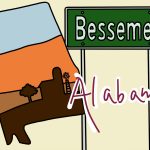You have likely heard Boston described as America’s greatest college town. While the city is obviously much more densely populated than the typical image of a charming suburban town with sweeping green campuses, Boston’s historical institutions of higher education have helped the city to become the economic powerhouse of New England.
From Berkeley to Blacksburg, Chapel Hill to College Station, college towns play a fundamental role in the American experience. These cities and towns are the setting for the formative years of many students from the United States and around the world, but these mid-sized metropolises could also be the home for reshaping the future of American urbanism.
I’ve tried my best in this column to avoid writing about college towns because they tend to already hold more public recognition in comparison to other small towns. But also because I was born and raised in Urbana, Illinois, home of the University of Illinois flagship institution’s campus. I admittedly carry a bias, having enjoyed my childhood in a college town, but there is a lot to love about college towns, and a lot to consider about what makes them great places to live.
A large state university is a behemoth of an institution, wiedling the financial power to draw outside investment into the rest of the town. The universities spend millions on research, administration and community services, often making them the largest employer in the town. Even in the global economy of Boston, home to some of the world’s largest companies, Boston University is ranked in the top ten largest employers in the city.
A large university presence brings more positive influence than just financial, of course. Many college students do not own private vehicles, so in order to accommodate large numbers of car-free citizens, public transportation and walkability is often emphasized more in college towns than other places. According to pre-pandemic data, college towns made up roughly half of the top 20 metro areas with highest public transportation ridership. With a focus on urban amenities that can be accessed without a car, college towns are great at starting the fight for sustainable planning.

Universities are also frequent champions of diversity, placing emphasis on hiring faculty and recruiting students from many different backgrounds. It’s a tough balance to strike that colleges can often do well — maintaining the educated and global community of a large city with the relative quiet and sense of belonging found in smaller towns. While universities have a great effect on diversifying the demographics of a population, they can have the opposite effect on the city’s economy.
If not addressed properly, college towns can become over-reliant on their universities for economic security. University enrollment is often thought of as relatively stable, but total enrollment rates actually dropped 5% between 2009 and 2019. When towns like Ypsilanti and Carbondale, home to Western Michigan University and Southern Illinois University respectively, saw enrollment drop in their local universities, the impact rippled throughout the community. Without as much tuition income, the universities had to lay off faculty and cut several departments.
While there is evidence of slowing enrollment rates in recent years, higher education is an industry worth hundreds of billions of dollars, so the vast majority of college towns aren’t going anywhere. In many senses, universities can be examples of what to strive for in building an effective urban environment.
BU, for example, provides its community with free shuttle transportation, access to important health and wellbeing services, walkable shopping and entertainment venues and promotes cultural and social engagement. If these practices were adopted effectively by more local governments, large and small, the country would find itself in a much better position to fight growing concerns of social inequality and climate change.
Even though the college experience might not include the bucket-list items of the American dream, namely a single-family suburban home with a nice car or two, many look back on their time in college as some of the most enjoyable years of their life. If we as informed citizens organize our cities to prioritize community building and transit access like the nation’s leading universities do, we can make the memorability of the college experience last for an entire lifetime.




